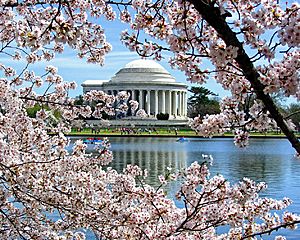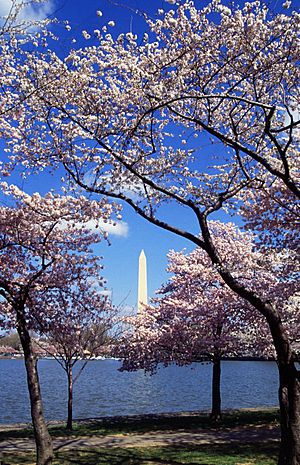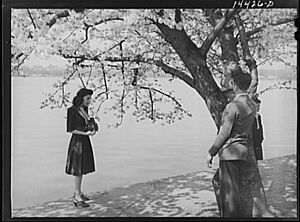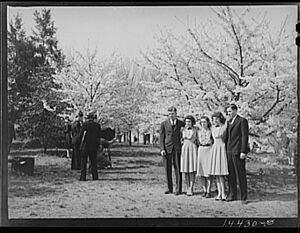National Cherry Blossom Festival facts for kids
The National Cherry Blossom Festival is a big spring party in Washington, D.C.. It celebrates a special gift of Japanese cherry trees. On March 27, 1912, Mayor Yukio Ozaki of Tokyo City gave these trees to Washington, D.C. This gift helped show the growing friendship between the United States and Japan. The festival includes colorful balloons, floats, marching bands, music, and many fun events.
Contents
The Story of the Cherry Trees
How the Trees Came to Be Planted
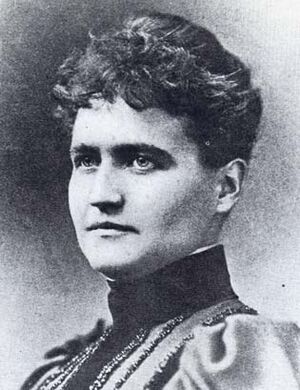

People wanted to bring cherry blossom trees to Washington, D.C., for many years before they were actually planted. In 1885, Eliza Ruhamah Scidmore came back from Japan with an idea. She wanted to plant cherry trees along the Potomac River. She kept suggesting this idea for 24 years!
In 1906, a botanist named David Fairchild brought 1000 cherry trees from Japan. He planted them at his home in Chevy Chase, Maryland. He and his wife loved them. In 1907, they started telling everyone that Japanese cherry trees would be perfect for Washington, D.C. Fairchild even gave cherry tree saplings to D.C. schools for Arbor Day in 1908.
In 1909, Eliza Scidmore decided to buy the trees herself. She wrote to First Lady Helen Herron Taft, wife of President Taft. Mrs. Taft loved the idea! She thought a long avenue of trees would be beautiful.
A Japanese chemist, Jōkichi Takamine, and the Japanese consul, Mr. Kokichi Midzuno, heard about the plan. They offered to donate 2000 more trees from Tokyo. Mrs. Taft happily accepted this generous offer.
On April 13, 1909, ninety cherry trees were planted along the Potomac River. These were bought locally.
Then, on January 6, 1910, the 2000 trees from Tokyo arrived. But there was a big problem! Experts from the United States Department of Agriculture found that the trees had insects and worms. To protect other plants, President Taft ordered the trees to be burned. Everyone was very sad about this.
But Japan didn't give up! Takamine offered to donate even more trees, 3020 in total. These new trees came from a famous group of trees along the Arakawa River in Tokyo. They were shipped on February 14, 1912, and arrived in D.C. on March 26.
Many important people worked behind the scenes to make this gift happen. Prince Iyesato Tokugawa of Japan played a key role. He was a very influential leader and wanted to build friendship between Japan and the U.S. He met with President Taft and helped arrange the gift. He wanted the gift to be seen as coming directly from Tokyo to Washington, D.C., to show goodwill.
The Japanese Gift is Planted
On March 27, 1912, a special ceremony took place. First Lady Helen Herron Taft and Viscountess Chinda, wife of the Japanese ambassador, planted the first two trees. These two original trees still stand today near the Tidal Basin. To show thanks, the U.S. later sent flowering dogwood trees to Japan.

From 1913 to 1920, many of the new trees were planted around the Tidal Basin and in East Potomac Park. In 1927, American school children re-enacted the first planting. This event is seen as the very first D.C. cherry blossom festival.
A National Yearly Event
The first official "Cherry Blossom Festival" was held in 1934. By 1935, it became a national yearly event. The cherry trees were now a beloved part of the nation's capital. In 1938, some trees were almost cut down for the Jefferson Memorial. But a group of women protested by chaining themselves together! A compromise was made to plant more trees. A Cherry Blossom Pageant started in 1940.
In 1937, the Garden Club of America gave 5,000 flowering trees to Japan. Prince Tokugawa, who helped with the original gift, received this new gift in Tokyo.
During World War II, four trees were cut down in 1941. People thought it was because of the attack on Pearl Harbor. To protect the trees, they were called "Oriental" flowering cherry trees during the war. The festival stopped during the war but started again in 1947.
In 1948, the Cherry Blossom Princess and Queen program began. A princess is chosen from each state, and one queen reigns over the festival. In 1952, Japan asked for help to restore their cherry trees along the Arakawa River, which had been damaged during the war. The U.S. sent budwood back to Tokyo to help.
In 1954, the governor of Tokyo gave Washington a 300-year-old granite lantern. It celebrates the 1854 Japan-US Treaty of Amity and Friendship. Every year, the lighting of this lantern opens the festival.
Later, the Mikimoto Pearl Crown was donated. It has over 2 pounds of gold and 1,585 pearls! It's used to crown the Festival Queen. In 1965, Japan gave 3,800 more Yoshino trees. First Lady Lady Bird Johnson accepted them.
Over the years, people have worked hard to keep the cherry trees healthy. Cuttings from the original 1912 trees were taken to ensure their genetic heritage continues. In 1999, fifty special Usuzumi trees from Japan were planted. These trees are very old and considered a National Treasure of Japan.
Festival Activities and Fun Events
The National Cherry Blossom Festival is organized by a special group. More than 700,000 people visit Washington each year to see the beautiful cherry trees. They mark the start of spring!
The festival lasts for three weeks. It starts with a Family Day at the National Building Museum and an opening ceremony. There's also a "Pink Tie Party" where people wear pink to celebrate spring. Many activities and cultural events happen every day. The Blossom Kite Festival is a popular event, usually on the first or second weekend. You can also find sushi/sake celebrations, classes about cherry blossoms, and bike tours. Other events include art shows, cultural performances, kimono fashion shows, dance, singing, and martial arts.
On a Saturday, a festival takes place on the Southwest Waterfront. When it ends, there's a fireworks show! The next morning, the Credit Union Cherry Blossom Ten Mile Run starts. Later that Sunday, important people light the 360-year-old Japanese stone lantern.
On the last Saturday, the National Cherry Blossom Festival Parade marches along Constitution Avenue. For many years, the Sakura Matsuri-Japanese Street Festival, a huge Japanese Cultural Festival, happened nearby. It moved in 2016 to a new location near the Navy Yard-Ballpark Metro station.
The festival also has "Cherry Blast," a cool event with art, dance, live music, and fashion. Since 2020, some events have changed due to the coronavirus pandemic. New activities like Petal Porches, Art in Bloom, and Paws & Petals have been added.
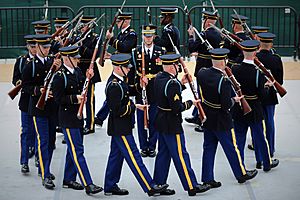
Different Kinds of Cherry Trees
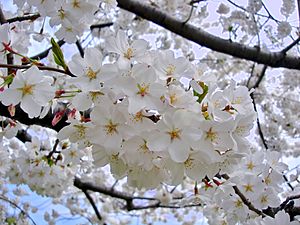
Out of the 3,020 trees originally given, two types are most common today: the Yoshino Cherry (about 70%) and the Kwanzan Cherry (about 13%).
The Yoshino trees have single white blossoms. They make the area around the Tidal Basin look like it's covered in white clouds. There are also some Akebono cherry trees, which bloom at the same time with pale-pink blossoms.
The Kwanzan trees grow mostly in East Potomac Park. They bloom about two weeks after the Yoshino trees. They have clusters of bright pink, double blossoms. You can also find Fugenzo trees with rosy pink blossoms and Shirofugen trees with white blossoms that turn pink.
You might also see Weeping Cherry trees. They have different shades of pink and white blossoms and bloom about a week before the Yoshino. Other types include the Autumn Cherry (pink), Sargent Cherry (deep pink), and Usuzumi (white-grey).
Images for kids
-
Cherry blossoms on the National Mall.
-
Cherry blossoms along the Tidal Basin.
-
Cherry blossoms surrounding the MLK Memorial.
-
Blossoms at the FDR Memorial.
See also
 In Spanish: Festival Nacional de los Cerezos en Flor para niños
In Spanish: Festival Nacional de los Cerezos en Flor para niños
- Branch Brook Park, largest collection of cherry blossom trees in the United States
- Hanami, Cherry Blossom Viewing in Japanese
- International Cherry Blossom Festival, Macon, Georgia
- Canadian Tulip Festival, a festival celebrating a similar gift from the Dutch royal family


